Dzmitry Bahdanau
StarCoder: may the source be with you!
May 09, 2023Abstract:The BigCode community, an open-scientific collaboration working on the responsible development of Large Language Models for Code (Code LLMs), introduces StarCoder and StarCoderBase: 15.5B parameter models with 8K context length, infilling capabilities and fast large-batch inference enabled by multi-query attention. StarCoderBase is trained on 1 trillion tokens sourced from The Stack, a large collection of permissively licensed GitHub repositories with inspection tools and an opt-out process. We fine-tuned StarCoderBase on 35B Python tokens, resulting in the creation of StarCoder. We perform the most comprehensive evaluation of Code LLMs to date and show that StarCoderBase outperforms every open Code LLM that supports multiple programming languages and matches or outperforms the OpenAI code-cushman-001 model. Furthermore, StarCoder outperforms every model that is fine-tuned on Python, can be prompted to achieve 40\% pass@1 on HumanEval, and still retains its performance on other programming languages. We take several important steps towards a safe open-access model release, including an improved PII redaction pipeline and a novel attribution tracing tool, and make the StarCoder models publicly available under a more commercially viable version of the Open Responsible AI Model license.
SantaCoder: don't reach for the stars!
Jan 09, 2023



Abstract:The BigCode project is an open-scientific collaboration working on the responsible development of large language models for code. This tech report describes the progress of the collaboration until December 2022, outlining the current state of the Personally Identifiable Information (PII) redaction pipeline, the experiments conducted to de-risk the model architecture, and the experiments investigating better preprocessing methods for the training data. We train 1.1B parameter models on the Java, JavaScript, and Python subsets of The Stack and evaluate them on the MultiPL-E text-to-code benchmark. We find that more aggressive filtering of near-duplicates can further boost performance and, surprisingly, that selecting files from repositories with 5+ GitHub stars deteriorates performance significantly. Our best model outperforms previous open-source multilingual code generation models (InCoder-6.7B and CodeGen-Multi-2.7B) in both left-to-right generation and infilling on the Java, JavaScript, and Python portions of MultiPL-E, despite being a substantially smaller model. All models are released under an OpenRAIL license at https://hf.co/bigcode.
The Stack: 3 TB of permissively licensed source code
Nov 20, 2022



Abstract:Large Language Models (LLMs) play an ever-increasing role in the field of Artificial Intelligence (AI)--not only for natural language processing but also for code understanding and generation. To stimulate open and responsible research on LLMs for code, we introduce The Stack, a 3.1 TB dataset consisting of permissively licensed source code in 30 programming languages. We describe how we collect the full dataset, construct a permissively licensed subset, present a data governance plan, discuss limitations, and show promising results on text2code benchmarks by training 350M-parameter decoders on different Python subsets. We find that (1) near-deduplicating the data significantly boosts performance across all experiments, and (2) it is possible to match previously reported HumanEval and MBPP performance using only permissively licensed data. We make the dataset available at https://hf.co/BigCode, provide a tool called "Am I in The Stack" (https://hf.co/spaces/bigcode/in-the-stack) for developers to search The Stack for copies of their code, and provide a process for code to be removed from the dataset by following the instructions at https://www.bigcode-project.org/docs/about/the-stack/.
On the Compositional Generalization Gap of In-Context Learning
Nov 15, 2022Abstract:Pretrained large generative language models have shown great performance on many tasks, but exhibit low compositional generalization abilities. Scaling such models has been shown to improve their performance on various NLP tasks even just by conditioning them on a few examples to solve the task without any fine-tuning (also known as in-context learning). In this work, we look at the gap between the in-distribution (ID) and out-of-distribution (OOD) performance of such models in semantic parsing tasks with in-context learning. In the ID settings, the demonstrations are from the same split (test or train) that the model is being evaluated on, and in the OOD settings, they are from the other split. We look at how the relative generalization gap of in-context learning evolves as models are scaled up. We evaluate four model families, OPT, BLOOM, CodeGen and Codex on three semantic parsing datasets, CFQ, SCAN and GeoQuery with different number of exemplars, and observe a trend of decreasing relative generalization gap as models are scaled up.
LAGr: Label Aligned Graphs for Better Systematic Generalization in Semantic Parsing
Jun 01, 2022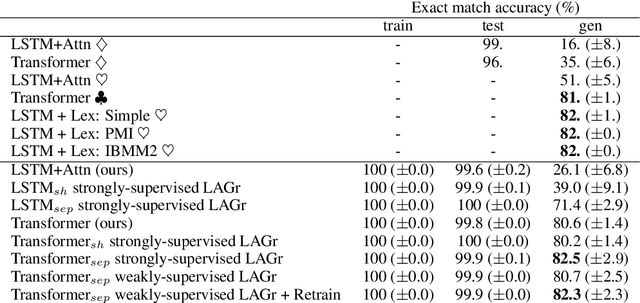

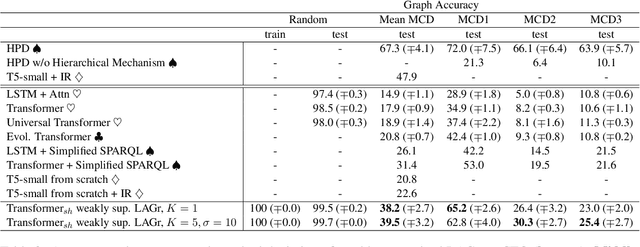
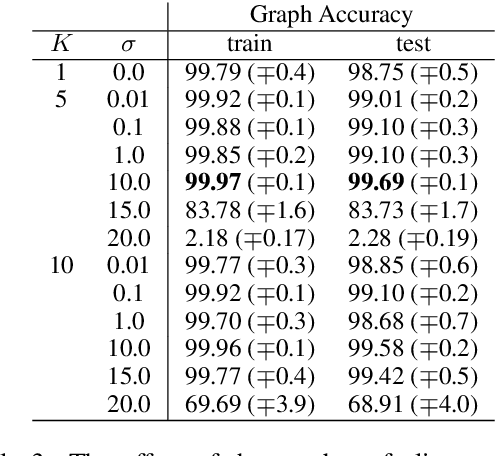
Abstract:Semantic parsing is the task of producing structured meaning representations for natural language sentences. Recent research has pointed out that the commonly-used sequence-to-sequence (seq2seq) semantic parsers struggle to generalize systematically, i.e. to handle examples that require recombining known knowledge in novel settings. In this work, we show that better systematic generalization can be achieved by producing the meaning representation directly as a graph and not as a sequence. To this end we propose LAGr (Label Aligned Graphs), a general framework to produce semantic parses by independently predicting node and edge labels for a complete multi-layer input-aligned graph. The strongly-supervised LAGr algorithm requires aligned graphs as inputs, whereas weakly-supervised LAGr infers alignments for originally unaligned target graphs using approximate maximum-a-posteriori inference. Experiments demonstrate that LAGr achieves significant improvements in systematic generalization upon the baseline seq2seq parsers in both strongly- and weakly-supervised settings.
Data Augmentation for Intent Classification with Off-the-shelf Large Language Models
Apr 05, 2022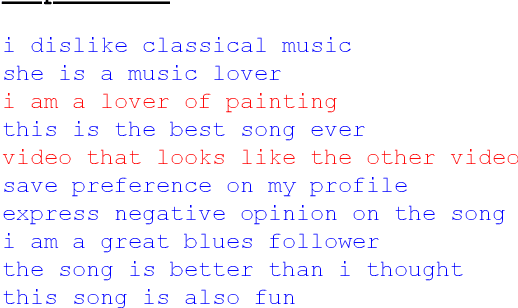
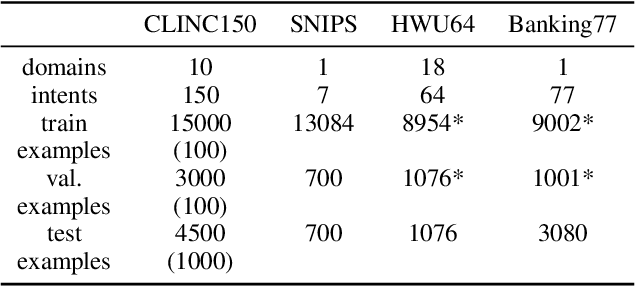
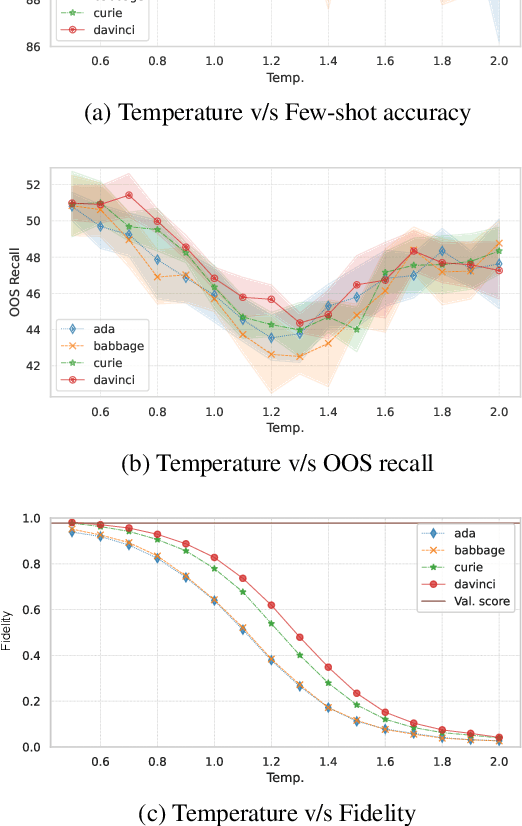
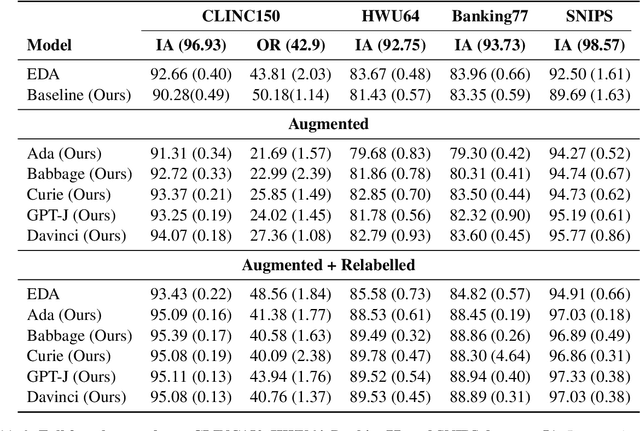
Abstract:Data augmentation is a widely employed technique to alleviate the problem of data scarcity. In this work, we propose a prompting-based approach to generate labelled training data for intent classification with off-the-shelf language models (LMs) such as GPT-3. An advantage of this method is that no task-specific LM-fine-tuning for data generation is required; hence the method requires no hyper-parameter tuning and is applicable even when the available training data is very scarce. We evaluate the proposed method in a few-shot setting on four diverse intent classification tasks. We find that GPT-generated data significantly boosts the performance of intent classifiers when intents in consideration are sufficiently distinct from each other. In tasks with semantically close intents, we observe that the generated data is less helpful. Our analysis shows that this is because GPT often generates utterances that belong to a closely-related intent instead of the desired one. We present preliminary evidence that a prompting-based GPT classifier could be helpful in filtering the generated data to enhance its quality.
Evaluating the Text-to-SQL Capabilities of Large Language Models
Mar 15, 2022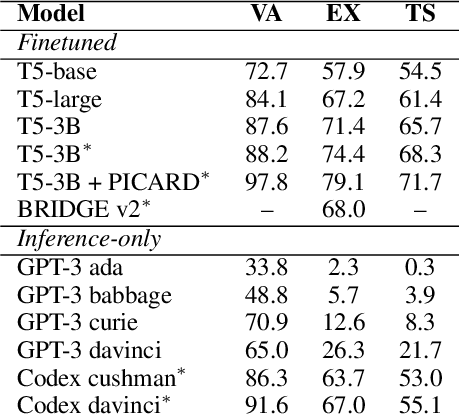
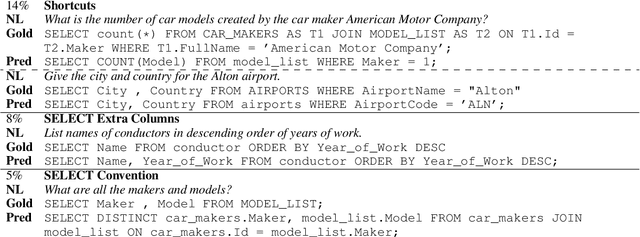
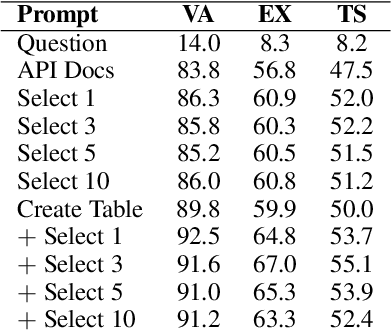
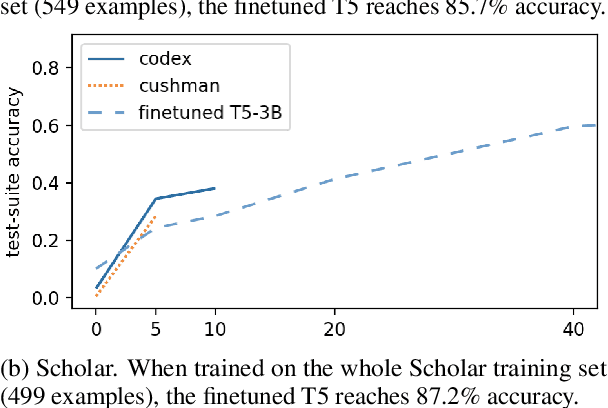
Abstract:We perform an empirical evaluation of Text-to-SQL capabilities of the Codex language model. We find that, without any finetuning, Codex is a strong baseline on the Spider benchmark; we also analyze the failure modes of Codex in this setting. Furthermore, we demonstrate on the GeoQuery and Scholar benchmarks that a small number of in-domain examples provided in the prompt enables Codex to perform better than state-of-the-art models finetuned on such few-shot examples.
Systematic Generalization with Edge Transformers
Dec 01, 2021
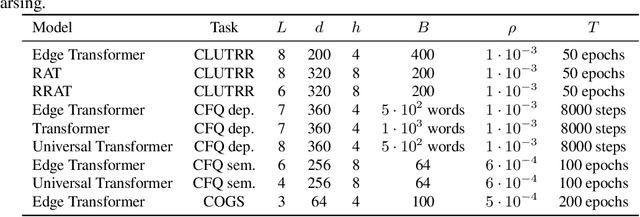
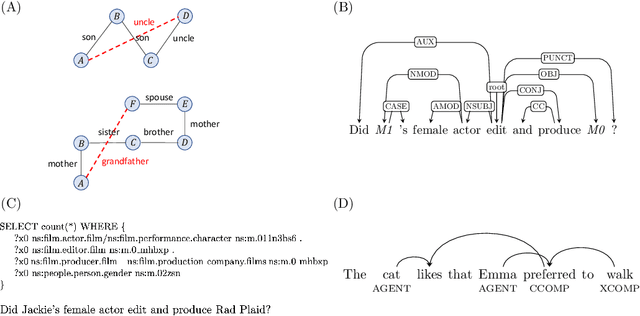

Abstract:Recent research suggests that systematic generalization in natural language understanding remains a challenge for state-of-the-art neural models such as Transformers and Graph Neural Networks. To tackle this challenge, we propose Edge Transformer, a new model that combines inspiration from Transformers and rule-based symbolic AI. The first key idea in Edge Transformers is to associate vector states with every edge, that is, with every pair of input nodes -- as opposed to just every node, as it is done in the Transformer model. The second major innovation is a triangular attention mechanism that updates edge representations in a way that is inspired by unification from logic programming. We evaluate Edge Transformer on compositional generalization benchmarks in relational reasoning, semantic parsing, and dependency parsing. In all three settings, the Edge Transformer outperforms Relation-aware, Universal and classical Transformer baselines.
LAGr: Labeling Aligned Graphs for Improving Systematic Generalization in Semantic Parsing
Oct 14, 2021
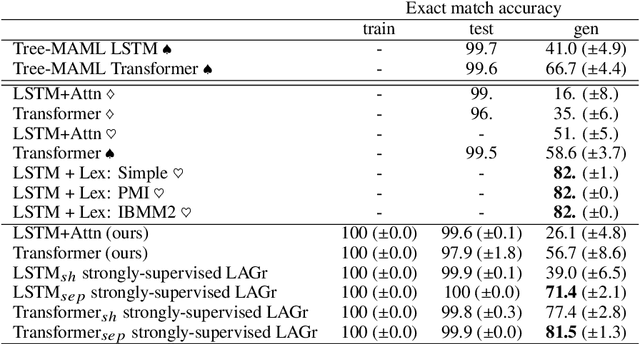
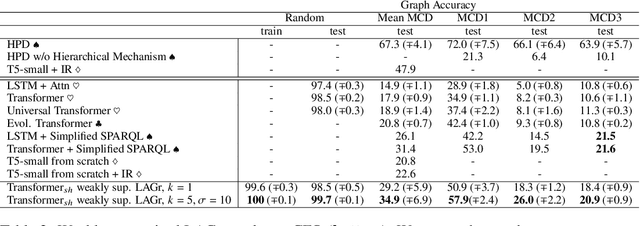
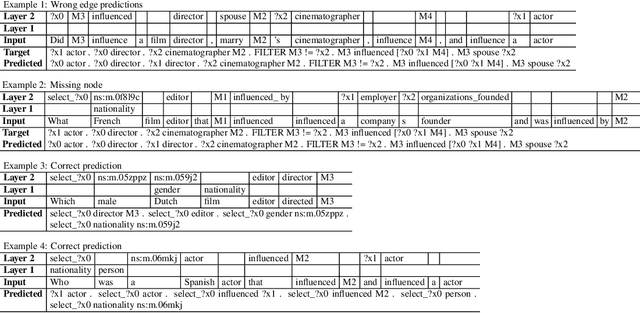
Abstract:Semantic parsing is the task of producing a structured meaning representation for natural language utterances or questions. Recent research has pointed out that the commonly-used sequence-to-sequence (seq2seq) semantic parsers struggle to generalize systematically, i.e. to handle examples that require recombining known knowledge in novel settings. In this work, we show that better systematic generalization can be achieved by producing the meaning representation (MR) directly as a graph and not as a sequence. To this end we propose LAGr, the Labeling Aligned Graphs algorithm that produces semantic parses by predicting node and edge labels for a complete multi-layer input-aligned graph. The strongly-supervised LAGr algorithm requires aligned graphs as inputs, whereas weakly-supervised LAGr infers alignments for originally unaligned target graphs using an approximate MAP inference procedure. On the COGS and CFQ compositional generalization benchmarks the strongly- and weakly- supervised LAGr algorithms achieve significant improvements upon the baseline seq2seq parsers.
Compositional Generalization in Dependency Parsing
Oct 13, 2021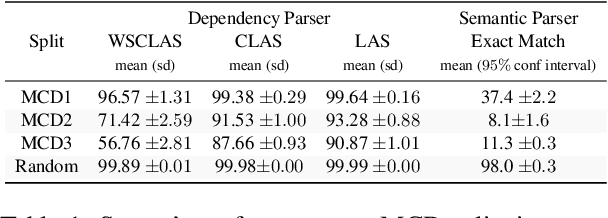
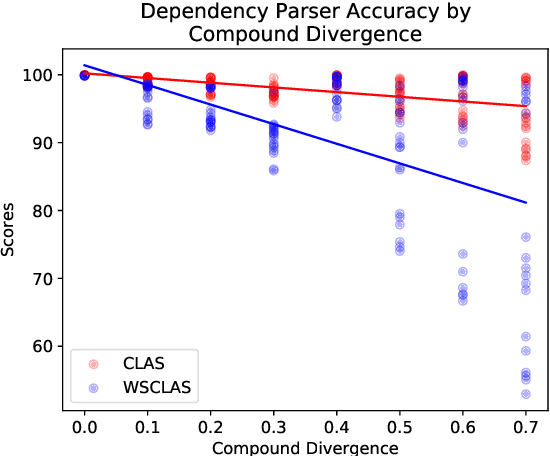
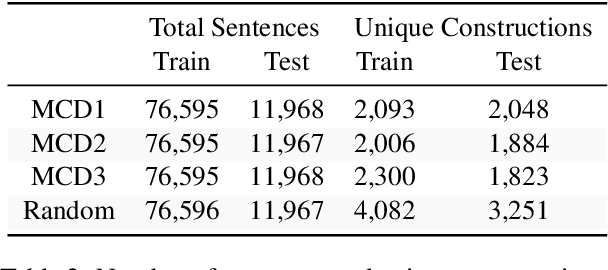
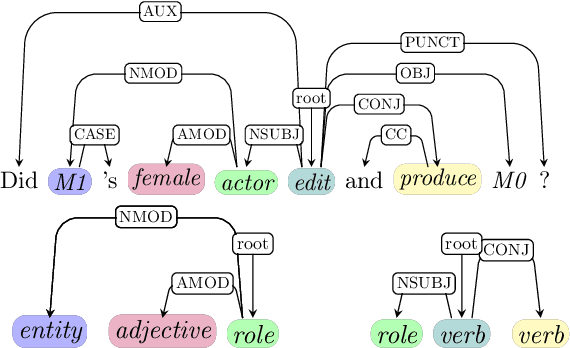
Abstract:Compositionality, or the ability to combine familiar units like words into novel phrases and sentences, has been the focus of intense interest in artificial intelligence in recent years. To test compositional generalization in semantic parsing, Keysers et al. (2020) introduced Compositional Freebase Queries (CFQ). This dataset maximizes the similarity between the test and train distributions over primitive units, like words, while maximizing the compound divergence: the dissimilarity between test and train distributions over larger structures, like phrases. Dependency parsing, however, lacks a compositional generalization benchmark. In this work, we introduce a gold-standard set of dependency parses for CFQ, and use this to analyze the behavior of a state-of-the art dependency parser (Qi et al., 2020) on the CFQ dataset. We find that increasing compound divergence degrades dependency parsing performance, although not as dramatically as semantic parsing performance. Additionally, we find the performance of the dependency parser does not uniformly degrade relative to compound divergence, and the parser performs differently on different splits with the same compound divergence. We explore a number of hypotheses for what causes the non-uniform degradation in dependency parsing performance, and identify a number of syntactic structures that drive the dependency parser's lower performance on the most challenging splits.
 Add to Chrome
Add to Chrome Add to Firefox
Add to Firefox Add to Edge
Add to Edge